- Home
- J. T. Edson
A Horse Called Mogollon (Floating Outfit Book 3)
A Horse Called Mogollon (Floating Outfit Book 3) Read online
When Colin Farquharson refused to sell the horse called Mogollon to Beatrice, Vicomtesse de Brioude, her husband swore to make him change his mind. To help him enforce his will upon the Scot, the Vicomte had a bunch of hired killers and a dozen cavalrymen commanded by an ambitious lieutenant besotted by the voluptuous Vicomtesse. Against them, the Scot had ten Mexican mesteneros and three Texas cowhands not yet twenty years of age. They were Ole Devil Hardin’s newly-formed floating outfit. Mark Counter, a handsome blond giant with the strength of a Hercules and a brace of real fast guns. The Ysabel Kid, baby-faced but deadly expert in the use of a Winchester rifle or a bowie knife. And their leader. Small, insignificant in appearance, he looked more like the horse-wrangler than the segundo of the biggest ranch in Texas. His name was Dusty Fog
Although the Vicomte did not know it, taking the horse called Mogollon would be far from as easy as he imagined.
A HORSE CALLED MOGOLLON
THE FLOATING OUTFIT 3
By J. T. Edson
First published by Brown Watson Ltd in 1971
Copyright © 1970, 2015 by J. T. Edson
First Smashwords Edition: October 2015
Names, characters and incidents in this book are fictional, and any resemblance to actual events, locales, organizations, or persons living or dead is purely coincidental.
All rights reserved. No part of this book may be reproduced or transmitted in any form or by any means, electronic or mechanical, including photocopying, recording or by any information or storage and retrieval system, without the written permission of the author, except where permitted by law.
This is a Piccadilly Publishing Book
Series Editor: Ben Bridges ~*~ Text © Piccadilly Publishing
Published by Arrangement with the Author’s Agent.
For Pat Bacon. Keep selling my books, Pat, I’m much too idle to go to work.
Chapter One
‘Hold it!’ Jeanie Schell whispered urgently as her dainty dun gelding tossed its head back, snuffled the breeze and cocked its ears towards the top of the slope up which her party was riding. ‘There’s hosses over the rim.’
Immediately her two companions reined their mounts to a stop. Dusty Fog and Colin Farquharson had known the girl for long enough to be satisfied that she could read her gelding’s reactions correctly.
Small, petite, her reddish-brown hair a short, curly halo about an attractively-tanned, pretty face, Jeanie had worked with horses almost all her life and knew their moods. Not yet twenty, she had a well-formed body fast maturing to womanhood. A low-crowned, wide-brimmed gray Stetson perched on the back of her head. She wore a dark green shirt tucked into Levi’s pants, the turned-back cuffs of which hung outside her high-heeled riding boots.
Like the girl, Dusty Fog had been born and raised in Texas: although they came from different backgrounds. His clan owned most of the land in Rio Hondo County. Jeanie’s late father had been a mustanger, a catcher and breaker of wild horses, and her home wherever the family’s wagon came to a halt.
Barely six inches taller than Jeanie’s five foot height, Dusty had a width to his shoulders that, taken with his slender waist, hinted at an exceptional muscular development. Despite their being expensive and well tailored, he made his clothes look like somebody’s hand-me-downs in a way which took most of the emphasis from his physique and made him appear almost insignificant. Not even the excellent design and workmanship of his gun belt, with twin bone-handled 1860 Army Colts in the cross-draw holsters, tended to render him more impressive at first glance.
If an observer chanced to examine him closer, certain facts grew into focus. There was much more to the short, dusty-blond cowhand than appeared on the surface. His magnificent seventeen-hand paint stallion gave the first clue. Only a man of considerable equestrian ability could hope to remain on its back and control it and he sat the low-horned, double-girthed range saddle with an almost effortless ease. Tilted at the traditional ‘jack-deuce’ angle over his right eye, his black Texas-style Stetson threw a shadow across a handsome face with strength, intelligence and power in its lines.
Maybe Dusty Fog presented a first impression of being a small nonentity, but few people in Texas regarded him in that light. During and since the recently ended War Between the States, he had achieved an almost legendary fame. At a young eighteen, he had worn the triple collar bars of a captain in the Confederate States’ Army. Leading the Texas Light Cavalry’s Company ‘C’, he had played havoc with the Yankees in Arkansas and built a reputation equal to Dixie’s other two daring military raiders, Turner Ashby and John Singleton Mosby. i Veterans of the Arkansas campaign boasted of his lightning fast draw and deadly accurate shooting with the matched Colts, or about his uncanny skill when fighting with his bare hands. It was whispered that he had prevented an attempt by Unionist fanatics to stir up an Indian war which would have decimated much of Texas; ii and had assisted Belle Boyd, the Rebel Spy, on two of her missions. iii After the War had ended, he had hoped to resume his interrupted career. Fate had made him segundo of the great OD Connected ranch iv and, again according to rumor, another turn of its wheel had sent him into Mexico on an assignment of considerable importance to the peace of the United States. v Having brought it off successfully, he and two members of his ranch’s crew had come to help the Schell family gather horses to rebuild the OD Connected’s remuda.
Dusty and Jeanie looked part of the scenery as they sat their horses on the slope about two miles north of the Guadalupe River’s headwaters in Kerr County, Texas. The same did not apply to the third member of the party. Despite having acquired the high honor of being regarded as a .44 caliber man, vi Colin Farquharson’s appearance seemed better suited to a Scottish Highland deer-forest.
Something over six foot in height, Colin had a muscular, powerful physique that went well with his ruggedly handsome features. A round, brimless bonnet rode at a jaunty angle on his brown hair, with an eagle’s feather angled backwards from under the silver insignia of the Clan Farquharson at its left side. The tight-rolled blue bandana trailed its ends over a conventional, open-necked gray shirt such as might have been worn by any Texas cowhand. About his waist was strapped a Western-pattern gun belt, with an ivory-handled Dragon Colt butt forwards at the right side in a low cavalry twist draw holster. In a metal-tipped leather sheath at the left of the belt hung a long Scottish dirk with a thistle-shaped, finely carved wooden hilt and a double-edged, spear-pointed blade.
So far, apart from his bonnet, Colin conformed with the dictates of local fashion. Nothing else of his attire did. Under the gun belt, extending to just above his bare knees, was a Farquharson-tartan kilt. Thick woolen stockings of the same black, dark-blue, deep green, check pattern, interspersed with red and yellow lines, covered his thick calves and disappeared into low-heeled, untanned boots. The hilt of a small, but deadly, sgian-dubh knife rose from the outside of the right stocking’s top.
While determined to remain and make Texas his permanent home, Colin still clung to some of the Highlander’s traditional style of dress. He possessed sufficient physical strength and all-round fighting ability to make sure that his right to do so would be respected.
‘Could be Lon coming back, Jeanie,’ Dusty commented. ‘Best make sure, though.’
Dismounting, they allowed their horses’ reins to dangle free and advanced up the slope on foot. Cautiously raising his head to peer over the rim, Colin pursed his trim-mustached lips in a silent whistle of admiration at what he saw in the valley beyond it. Dusty’s insistence on making sure of what awaited them had paid off and Colin considered it worthwhile.
About forty horses were grazing in the v
alley: mares, foals, yearlings and maybe a dozen young stallions. All looked to be finely bred and in the peak of condition. Over the past weeks, Colin had seen many similar sights. The years of the War had allowed the bands of wild horses to build up their numbers, just as it had permitted the longhorn cattle to increase practically unchecked by human agencies. Some of the manadas—a Spanish word adapted to mean a bunch of mustangs—had been larger in number than this one; but none had exceeded it in the excellence of its members’ conformation, especially amongst the younger animals.
‘Colin!’ Jeanie breathed, her left hand closing on his bulging right bicep and tightening as excitement put a vibrant thrill into her words. ‘That’s Mogollon and his band!’
Instantly the Scot’s interest increased. Ever since throwing in his lot with the Schell family, he had been hearing about the horse called Mogollon. The Clan Farquharson was noted for their knowledge of matters equestrian, but a man did not need to be an expert to recognize Mogollon. Even amongst the well-shaped members of its manada, the manadero stood out from all the others. Not even the largest of the immature stallions still tolerated by their sire came up to Mogollon in size.
The master stallion stood a full seventeen hands. Large at the shoe, concave in the sole, open at the heel, provided with a big, flexible frog, each hoof narrowed a little to the coronet. They were feet ideally suited to withstand the poundings and strains thrown upon them by carrying the manadero’s mighty body. Above the coronets, the pasterns angled correctly, being neither too sloping nor too upright. Short in proportion to the forearms, the cannon bones gave the impression of a razor-like flatness. Long, not too horizontal forearms joined powerful, sloping shoulders which made the withers lie farther rearwards than the elbows. While they did not ‘come out of the same hole’, as mustangers expressed it, the front legs were close enough together to avoid giving a rolling, paddling vii gait.
Short and strong of back, with the ribcage well sprung to give plenty of room for heart, lungs and other vital organs, it carried smoothly into long and slightly-sloping hips. Designed as the major portions of the propulsion mechanism, the stifles had a muscular development that told of enormous power. Set high on the body, the long tail arched and flowed proudly as Mogollon moved.
Of perfect proportions, the neck arched elegantly, being fine and flexible where it connected to the head at the poll. The head had an almost classical diamond configuration, with plenty of brain space above the eyes. Carried upright, the ears moved constantly to catch any warning sound. Set well out at the sides of the head, the eyes commanded a wide range of vision and glinted brightly with health. Although the face narrowed down at the muzzle, the jaws were wide at their junction with the neck, giving ample space for the windpipe. The lips closed firmly over the teeth and the nostrils, fine at the edges, flared open for easy respiration. Composed of perfectly straight hair, the forelock and mane were not particularly voluminous—hinting at a good bloodline—and swept down the left of the neck.
Glowing with health, rippling with steel-spring powerful muscles, the stallion’s dark liver-colored chestnut hide carried a small white star in the center of its forehead and a white sock on each of its legs.
Watching the stallion as it stood grazing clear of the manada, with frequent pauses to search the surrounding area for danger to its band, one might have imagined that it had always been a free-ranging creature of the wild. Such was not the case. It had been brought into Texas as a war-mount by one of a raiding Mogollon Apache band just before the War Between the States. By the time its owner had been shot from its back, the big young horse had attracted much attention by its speed and endurance. Those qualities had been so effective that the rest of the war party could not catch the horse before being driven back to their own country by Jack Cureton’s Company of Texas Rangers.
Since that time many stories had grown around the chestnut stallion left behind by the Apaches. Gaining control of a manada, it had not only held its growing harem against the other male horses but led them to safety through many attempts by human beings to trap them. Men had started speaking of it as ‘that Mogollon’s horse’, then shortened the name to Mogollon.
‘So that’s Mogollon, Jeanie,’ Dusty said. ‘I’ve heard your pappy talk about it. Curse it some too.’
‘He sure did,’ the girl agreed, looking at the manadero with longing eyes. ‘Pappy tried most every year, but even he couldn’t lay hold of that Mogollon hoss. Each time Pappy would say, “Never again,” but we’d always come back for another go.’
‘I can see why,’ Colin remarked. ‘Yon’s a fine horse, lassie.’
‘Pappy allus had his heart set on taking Mogollon,’ Jeanie replied, her Texas drawl wistful and her fingers slackening their grip on Colin’s arm. ‘Not to sell, though. He always allowed if we ever got him we’d keep him as a stud.’
‘He’d make a good one at that,’ the Scot confirmed, indicating the manadero’s shapely offspring. ‘Look at the young ones he’s sired.’
‘He leaves his mark on them for sure,’ Dusty drawled. ‘Do you reckon we can take him, Jeanie?’
‘If only we could!’ the girl sighed. ‘Like I said, Pappy tried plenty of times and ways.’
‘With your ma, Mark and half the mesteneros off delivering the first of the Army’s remounts to Fort Sawyer, we’re a mite short-handed,’ Dusty went on. ‘But we could make a stab at it.’
‘He doesn’t know we’re around,’ Jeanie breathed, looking back the way she and the two men had come but failing to see any sign of the remainder of her family’s Mexican assistants. ‘When Felix and the rest of the boys catch up with us, we might be—’
Before she could finish, Jeanie heard sounds across the valley. Swinging her gaze to the front, she noticed that Mogollon had also heard the noise. Pivoting around with the agility so sought in a cutting-horse, the stallion thrust up its head as far as its neck would allow and stared up the slope. Other members of the manada turned their attention in the same direction. Snorts broke from the horses and they moved around restlessly as they awaited their master’s instructions.
With tails raised so the snow-white hairs flashed a warning, half-a-dozen buck whitetail deer appeared on the rim. They travelled at a fast gallop, instead of using the more usual canter interspersed by a succession of low leaps followed by a long, broad jump. That was a sure sign of an enemy close behind. Five of the band streaked down the slope in the direction of the horses. As the sixth buck topped the rim, the flat crack of a rifle shot sounded from behind it. Leaving the ground in a back-humping bound, the buck seemed to crumple in mid-air. It buckled forward, crashed to the earth on its side and slid lifeless down the incline for a few feet then came to a stop.
Even before the shot rang out, Mogollon had decided that the deer heralded danger. So it cut loose with a commanding blast of a high-pitched whickering. Instantly the remainder of the manada started moving. Taking the lead, the two oldest mares set off along the bottom of the valley. After a swift swing of its shapely head, as if checking that all of its family had fled, Mogollon strode along after them. Although clearly faster than the other horses, the big stallion did not attempt to go by them. Only rarely did a manadero lead its band in flight. Mostly it brought up the rear, holding the others bunched and urging on the laggards with snapping teeth. If the master-stallion should decide that a change of direction was necessary, it would increase its speed until it caught the leaders and enforce its will with a ramming shoulder-thrust. With the line of flight altered to its satisfaction, it would drop back to its usual position.
‘What—!’ Jeanie gasped as the shooting of the deer speeded the hurried departure of the manada. ‘Who the—’
As if in answer to her question, the deer’s killer crossed the rim. Smoke curled lazily from the rifle in his right hand and he sat afork a great white stallion with such relaxed grace that he might have been a part of it. The horse was fully as big, fine and wild looking as Mogollon despite wearing bridle, bit, rei
ns and a low-horned double girthed saddle as badges of servitude.
In a way the rider seemed to match his mount’s untamed appearance. Around six foot in height, he had a lean, wiry build that spoke of endurance, agility and steel-spring resilience. Clad in cowhand clothing of all black, from his hat to his boots, he matched Colin’s waist armament except that his Dragoon sported plain walnut grips and his knife was a genuine, ivory-hilted James Black bowie. Tanned to an almost Indian darkness, he had handsome features of nearly babyishly innocent aspect—except for his red-hazel eyes. They warned of his true, reckless, savage nature. Young he might look, but he rode and handled his rifle—one of the new model Henry’s soon to be given the name Winchester ’66, with casual competence beyond his apparent youth.
Throwing a glance after the fleeing horses, he dropped from his saddle by the buck’s body. Then his gaze swung across the valley. Detecting Jeanie, Dusty and Colin as they started to rise, he raised his left hand in a cheery wave. Putting aside his intention of gutting and bleeding the buck, he went astride his white with a lithe bound and rode in the trio’s direction.
‘Blast you, Lon Ysabel!’ Jeanie said indignantly as the dark-faced youngster approached. ‘You scared Mogollon off.’
An expression of pained resignation crossed the newcomer’s features and he raised his eyes to the heavens.
‘You hear that, Ka-Dih?’ the youngster demanded, mentioning the name of the Comanche Indians’ Great Spirit. ‘There just ain’t no pleasing white folks. “See if you-all can bring in some pot-meat, Lon,” she said, afore witnesses for shame, ’n’ when I do it, she starts to blister my hide.’ He looked at the girl and continued, ‘You sure it was me spooked them hosses, Jeanie-gal. Way you three was leaping up ’n’ down, it could’ve been you’s did it.’
‘Confounded Injun!’ Jeanie snorted. ‘Trust you to try ’n’ lay the blame on us white folks.’

 Calamity Jane 11
Calamity Jane 11 The Floating Outift 33
The Floating Outift 33 Cap Fog 5
Cap Fog 5 The Floating Outfit 34
The Floating Outfit 34 The Code of Dusty Fog
The Code of Dusty Fog The Floating Outfit 21
The Floating Outfit 21 The Floating Outift 36
The Floating Outift 36 Calamity Jane 2
Calamity Jane 2 Calamity Jane 6: The Hide and Horn Saloon (A Calamity Jane Western)
Calamity Jane 6: The Hide and Horn Saloon (A Calamity Jane Western) Waco 7
Waco 7 The Floating Outfit 25
The Floating Outfit 25 Waco 7: Hound Dog Man (A Waco Western)
Waco 7: Hound Dog Man (A Waco Western) The Floating Outfit 47
The Floating Outfit 47 The Floating Outfit 42: Buffalo Are Coming!
The Floating Outfit 42: Buffalo Are Coming!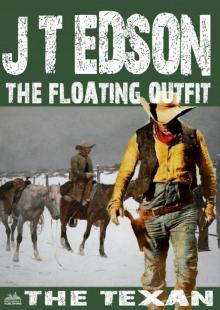 The Floating Outfit 46
The Floating Outfit 46 Dusty Fog's Civil War 11
Dusty Fog's Civil War 11 The Floating Outfit 61
The Floating Outfit 61 The Owlhoot
The Owlhoot Alvin Fog, Texas Ranger
Alvin Fog, Texas Ranger The Floating Outfit 34: To Arms! To Arms! In Dixie! (A Floating Outfit Western)
The Floating Outfit 34: To Arms! To Arms! In Dixie! (A Floating Outfit Western) The Floating Outfit 44
The Floating Outfit 44 Dusty Fog's Civil War 10
Dusty Fog's Civil War 10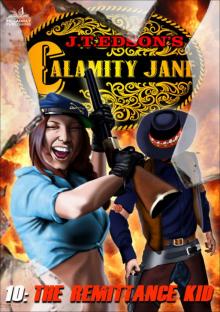 Calamity Jane 10
Calamity Jane 10 Cap Fog 4
Cap Fog 4 The Floating Outfit 51
The Floating Outfit 51 The Floating Outfit 50
The Floating Outfit 50 The Floating Outfit 49
The Floating Outfit 49 The Floating Outfit 10
The Floating Outfit 10 Apache Rampage
Apache Rampage The Floating Outfit 15
The Floating Outfit 15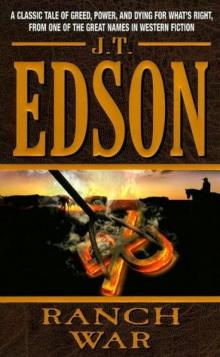 Ranch War
Ranch War The Floating Outfit 11
The Floating Outfit 11 The Devil Gun
The Devil Gun Sacrifice for the Quagga God (A Bunduki Jungle Adventure Book 3)
Sacrifice for the Quagga God (A Bunduki Jungle Adventure Book 3) Comanche (A J.T. Edson Western Book 1)
Comanche (A J.T. Edson Western Book 1) The Floating Outfit 48
The Floating Outfit 48 Wacos Debt
Wacos Debt The Rebel Spy
The Rebel Spy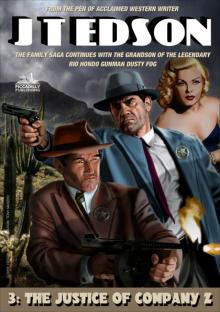 Cap Fog 3
Cap Fog 3 Trouble Trail
Trouble Trail Cold Deck, Hot Lead
Cold Deck, Hot Lead Rockabye County 4
Rockabye County 4 The Bullwhip Breed
The Bullwhip Breed Set Texas Back On Her Feet (A Floating Outfit Western Book 6)
Set Texas Back On Her Feet (A Floating Outfit Western Book 6)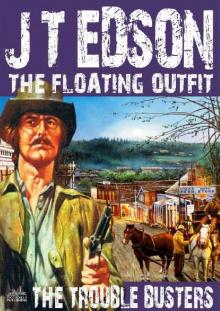 The Floating Outfit 25: The Trouble Busters (A Floating Outfit Western)
The Floating Outfit 25: The Trouble Busters (A Floating Outfit Western) Fearless Master of the Jungle (A Bunduki Jungle Adventure
Fearless Master of the Jungle (A Bunduki Jungle Adventure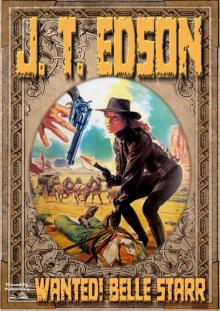 Wanted! Belle Starr!
Wanted! Belle Starr! The Big Hunt
The Big Hunt Running Irons
Running Irons The Floating Outfit 19
The Floating Outfit 19 You're in Command Now, Mr Fog
You're in Command Now, Mr Fog The Floating Outfit 27
The Floating Outfit 27 Texas Killers
Texas Killers Ole Devil and the Mule Train (An Ole Devil Western Book 3)
Ole Devil and the Mule Train (An Ole Devil Western Book 3) Bunduki and Dawn (A Bunduki Jungle Adventure Book 2)
Bunduki and Dawn (A Bunduki Jungle Adventure Book 2) The Fortune Hunters
The Fortune Hunters The Floating Outfit 12
The Floating Outfit 12 The Hide and Tallow Men (A Floating Outfit Western. Book 7)
The Hide and Tallow Men (A Floating Outfit Western. Book 7) Young Ole Devil
Young Ole Devil Slip Gun
Slip Gun The Drifter
The Drifter The Floating Outfit 45
The Floating Outfit 45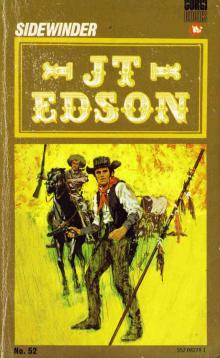 Sidewinder
Sidewinder The Ysabel Kid
The Ysabel Kid Waco 6
Waco 6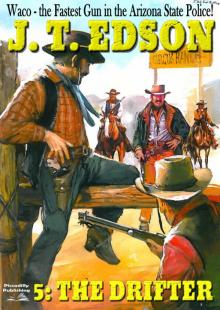 Waco 5
Waco 5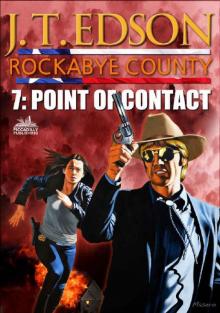 Point of Contact
Point of Contact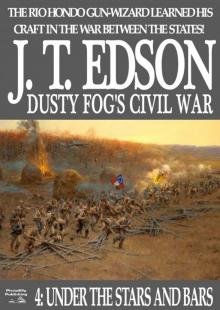 Under the Stars and Bars (A Dusty Fog Civil War Western Book 4)
Under the Stars and Bars (A Dusty Fog Civil War Western Book 4) The Floating Outfit 9
The Floating Outfit 9 Under the Stars and Bars
Under the Stars and Bars .44 Caliber Man
.44 Caliber Man The Floating Outfit 17
The Floating Outfit 17 Ole Devil at San Jacinto (Old Devil Hardin Western Book 4)
Ole Devil at San Jacinto (Old Devil Hardin Western Book 4) The Bloody Border
The Bloody Border A Horse Called Mogollon (Floating Outfit Book 3)
A Horse Called Mogollon (Floating Outfit Book 3) Waco 3
Waco 3 The Texan
The Texan The Floating Outfit 35
The Floating Outfit 35 Mississippi Raider
Mississippi Raider The Big Gun (Dusty Fog's Civil War Book 3)
The Big Gun (Dusty Fog's Civil War Book 3) Goodnight's Dream (A Floating Outfit Western Book 4)
Goodnight's Dream (A Floating Outfit Western Book 4) Waco 4
Waco 4 From Hide and Horn (A Floating Outfit Book Number 5)
From Hide and Horn (A Floating Outfit Book Number 5) The Floating Outfit 18
The Floating Outfit 18 Slaughter's Way (A J.T. Edson Western)
Slaughter's Way (A J.T. Edson Western) Dusty Fog's Civil War 7
Dusty Fog's Civil War 7 Two Miles to the Border (A J.T. Edson Western)
Two Miles to the Border (A J.T. Edson Western)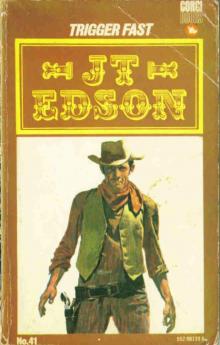 Trigger Fast
Trigger Fast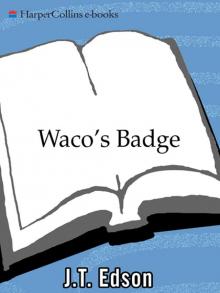 Waco's Badge
Waco's Badge A Matter of Honor (Dusty Fog Civil War Book 6)
A Matter of Honor (Dusty Fog Civil War Book 6) The Half Breed
The Half Breed Bunduki (Bunduki Series Book One)
Bunduki (Bunduki Series Book One) Kill Dusty Fog
Kill Dusty Fog Get Urrea! (An Ole Devil Hardin Western Book 5)
Get Urrea! (An Ole Devil Hardin Western Book 5) Dusty Fog's Civil War 9
Dusty Fog's Civil War 9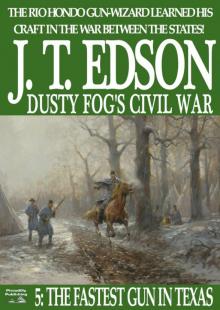 The Fastest Gun in Texas (A Dusty Fog Civil War Book 5)
The Fastest Gun in Texas (A Dusty Fog Civil War Book 5) Sagebrush Sleuth (A Waco Western #2)
Sagebrush Sleuth (A Waco Western #2) Quiet Town
Quiet Town Is-A-Man (A J.T. Edson Standalone Western)
Is-A-Man (A J.T. Edson Standalone Western) Rockabye County 5
Rockabye County 5 The Floating Outfit 14
The Floating Outfit 14 Cure the Texas Fever (A Waxahachie Smith Western--Book 3)
Cure the Texas Fever (A Waxahachie Smith Western--Book 3) The Floating Outfit 13
The Floating Outfit 13 The Road to Ratchet Creek
The Road to Ratchet Creek